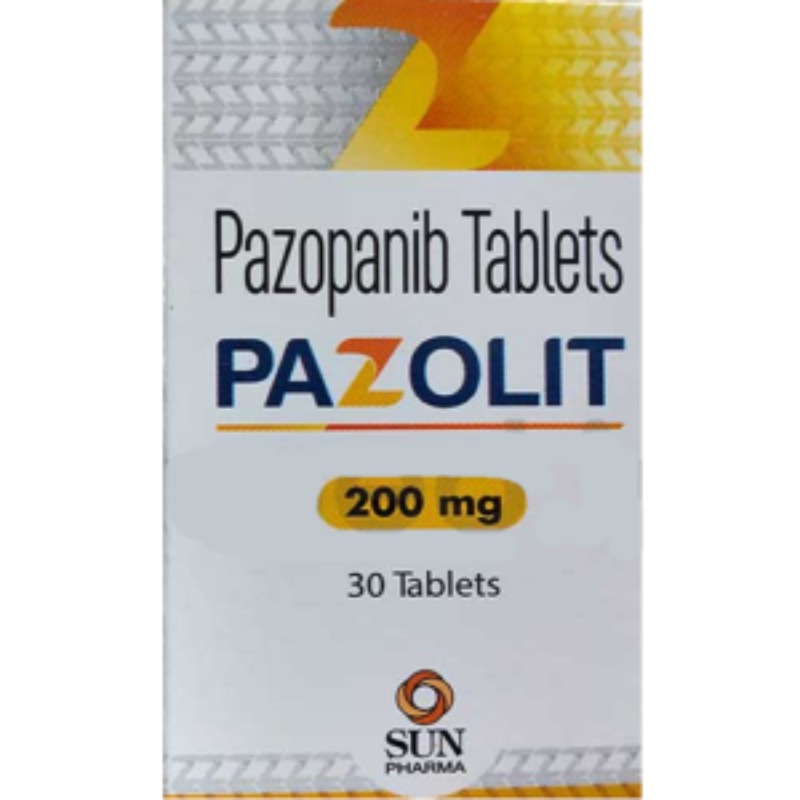DESCRIPTION
MECHANISM OF ACTION
• Oral multikinase inhibitor of angiogenesis.
• Inhibits VEGFR-1, VEGFR-2, VEGFR-3, platelet-derived growth factor receptor (PDGFR)-α and PDGFR–β, fibroblast growth factor receptor (FGFR)-1 and FGFR-3, c-Kit, interleukin-2 receptor inducible T-cell kinase, leukocyte-specific protein tyrosine kinase (Lck), and transmembrane glycoprotein receptor tyrosine kinase (c-Fms).
ABSORPTION
Pazopanib is absorbed orally with median time to peak concentrations of 2–4 hours. Systemic exposure to pazopanib is increased when administered with food. The bioavailability and the rate of pazopanib oral absorption are also increased after administration of the crushed tablet relative to administration of the whole tablet.
DISTRIBUTION
Extensive binding (> 99%) of pazopanib to plasma proteins.
INDICATIONS
• FDA-approved for advanced renal cell carcinoma.
• FDA-approved for advanced soft tissue sarcoma (STS) following treatment with prior chemotherapy. The efficacy of pazopanib has not been documented in adipocytic STS or GIST.
DOSAGE RANGE
Recommended dose is 800 mg PO once daily without food at least 1 hour before or 2 hours after a meal
DRUG INTERACTIONS 1
Concomitant administration of CYP3A4 inhibitors such as ketoconazole, itraconazole, clarithromycin, atazanavir, indinavir, nefazodone, nelfinavir, ritonavir, saquinavir, telithromycin, and voriconazole decreases the rate of pazopanib metabolism, resulting in increased drug levels and potentially increased toxicity.
DRUG INTERACTIONS 2
Concomitant administration of CYP3A4 inducers such as phenytoin, carbamazepine, rifampin, phenobarbital, and St. John’s Wort increases the rate of metabolism of pazopanib, resulting in its inactivation and reduced effective drug levels.
SPECIAL CONSIDERATIONS
1. Baseline and periodic evaluation of liver function tests (at weeks 3, 5, 7, and 9 and at months 3 and 4) should be performed while on pazopanib therapy. Patients with isolated SGOT elevations between 3 × ULN and 8 × ULN may be continued on therapy with weekly monitoring of LFTs until they return to grade 1 or baseline. In this setting, the dose of pazopanib should be reduced to 200 mg PO once daily. Patients with isolated SGOT elevations of more than 8 × ULN should have pazopanib therapy interrupted.
2. Use with caution in patients with moderate hepatic impairment, as drug clearance is reduced by at least 50% in this setting. No data are presently available in patients with mild or severe hepatic impairment.
3. Closely monitor ECG with QT measurement at baseline and periodically during therapy, as QT prolongation has been observed. Use with caution in patients at risk of developing QT prolongation, including hypokalemia, hypomagnesemia, congenital long QT syndrome, patients taking anti-arrhythmic medications or any other products that may cause QT prolongation, and in those with preexisting cardiac disease.
4. Avoid use in patients with a prior history of hemoptysis and cerebral or clinically significant GI hemorrhage within 6 months of initiation of pazopanib.
5. Use with caution in patients with cardiovascular and cerebrovascular disease, especially those with prior MI, angina, stroke, and TIA.
6. Closely monitor blood pressure while on therapy.
7. Blood pressure should be well controlled prior to initiation of pazopanib.
8. Closely monitor thyroid function tests, as pazopanib therapy results in hypothyroidism.
9. Baseline and periodic urinalysis during treatment is recommended, and pazopanib should be discontinued in the setting of grade 4 proteinuria
10. Avoid Seville oranges, starfruit, pomelos, grapefruit, and grapefruit products while on pazopanib therapy, as they can inhibit CYP3A4 activity, resulting in increased drug levels.
11. Pregnancy category D. Breastfeeding should be avoided.
TOXICITY 1
Hypertension occurs in nearly 50% of patients. Usually occurs within the first 18 weeks of therapy and is well controlled
with oral antihypertensive medications.
TOXICITY 2
Diarrhea, nausea/vomiting, and abdominal pain are the most common GI side effects. Elevations in serum lipase have been observed
in up to 30% of patients. Increased risk of GI fistulas and/or perforations.
TOXICITY 3
Fatigue, asthenia, and anorexia may be significant in some patients.
TOXICITY 4
Hair color changes with depigmentation.
TOXICITY 5
Bleeding complications with hematuria, epistaxis, and hemoptysis
TOXICITY 6
Increased risk of arterial thromboembolic events, including MI, angina, TIA, and stroke.
TOXICITY 7
Proteinuria develops in 8% of patients.
TOXICITY 8
Myelosuppression, with neutropenia and thrombocytopenia. Usually mild to moderate in severity
TOXICITY 9
Hypothyroidism
SPECIFICATION


Login To Comment